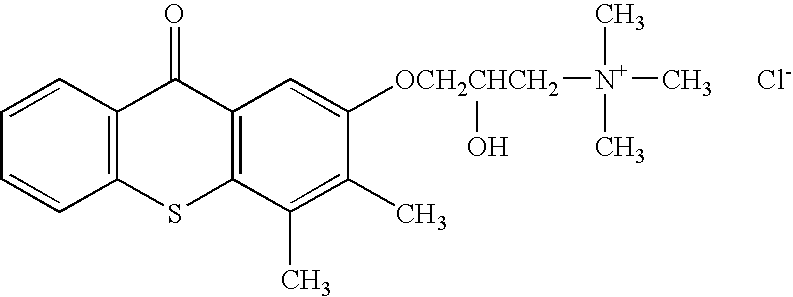Drug combinations to treat drug resistant tumors
a drug resistance and tumor technology, applied in the field of drug resistance treatment combinations for cancers, can solve problems such as the development of resistance to anti-cancer drugs, and achieve the effects of treating or and reducing drug resistance in cancers
- Summary
- Abstract
- Description
- Claims
- Application Information
AI Technical Summary
Benefits of technology
Problems solved by technology
Method used
Image
Examples
example 1
Synthesis of CCcompound104 or 9H-xanthene-9-carboxylic acid-3-{4[2-(4trimethylsilanyl-methoxy-benzoyloxy)-ethyl]piperazin-1-yl-propyl ester dihydrochloride
[0046]Structure:
Step 1: Synthesis of 4-trimethyl silylmethyl methyl benzoate (C12H18O3Si)
[0047]Structure:
[0048]NaH (4.4-g), supplied as 60% oily suspension, was washed over a glass filter with 2×50-ml absolute dimethylformamide to remove oil. In small portions, NaH was added slowly (over a 20 min time period) to 16.8-g of 4-hydroxymethylbenzoate previously dissolved in dimethylformamide (at room temperature with constant mixing with magnetic stirrer); mixing continued for 30 min after the last addition. The resulting suspension was placed on a 60° C. oil bath followed by drop-wise addition of 16.7-g of trimethylbromomethyl silane, previously dissolved in 50-ml dimethylformamide. The mixture was mixed for another 1-hour period and then taken off the oil bath. After the mixture reached the room temperature, the surplus NaH was react...
example 2
Cell Lines
[0060]The human breast cancer MCF-7 and MCF-7 / ADR (also called MCF-7 / MDR1) cells as well as the murine lymphocytic leukemia P388 and P388 / ADR (also called P388 / MDR1) cells were obtained from the National Cancer Institute, Bethesda, Md., Developmental Therapeutics Program Tumor Repository. These cell lines are frequently used models for the study of drug resistance [see, for example, Peer, D., Dekel, Y., Malikhov, D. and Margalit, R. (2004), “Fluxetine inhibits multidrug resistance extrusion pumps and enhances responses to chemotherapy in syngeneic and in human xenograft tumor models,”Cancer Res., 64, 7562-7569]. Importantly, the P388 / MDR1 cell line that was used contains only about 6-times more MDR1 protein than the parent cell line. This resembles the situation in human tumors that usually express only 2-5-fold more MDR1 than the normal tissue.
[0061]The two MCF-7 cell lines were grown in Richter's Iscove's modified Eagle medium (IMEM) supplemented with 2 mM glutamine, 12 ...
example 3
Separation of Lymphocytes
[0063]Heparinized peripheral-blood samples were obtained from chronic lymphocytic leukemia patients with more than 70% malignant cells after informed consent, in accordance with the Declaration of Helsinki. The blood samples (10-ml) were diluted 1:1 with cold phosphate buffered saline (PBS; 0.135 M NaCl, 2.7 mM KCl, 1.5 mM KH2PO4, 8 mM Na2HPO4 [pH 7.4]) and layered onto Ficoll-Hypaque (8-ml, specific gravity, 1.086; Life Technologies, Grand Island, N.Y.). Then, the blood was centrifuged at 433 g for 20 min, and mononuclear cells were removed from the interphase. Cells were washed twice with cold PBS and after each centrifugation step the pelleted cells were resuspended in 10-ml RPMI 1640 supplemented with 10% fetal bovine serum (inactivated for 30 min at 56° C.). A Coulter channelyzer (Coulter Electronics, Hialeah, Fla.) was used to determine the cell number. Then the number of cells was adjusted to 1×107 cells per 1 ml before using them for the experiments....
PUM
| Property | Measurement | Unit |
|---|---|---|
| temperature | aaaaa | aaaaa |
| temperature | aaaaa | aaaaa |
| temperature | aaaaa | aaaaa |
Abstract
Description
Claims
Application Information
 Login to View More
Login to View More - R&D
- Intellectual Property
- Life Sciences
- Materials
- Tech Scout
- Unparalleled Data Quality
- Higher Quality Content
- 60% Fewer Hallucinations
Browse by: Latest US Patents, China's latest patents, Technical Efficacy Thesaurus, Application Domain, Technology Topic, Popular Technical Reports.
© 2025 PatSnap. All rights reserved.Legal|Privacy policy|Modern Slavery Act Transparency Statement|Sitemap|About US| Contact US: help@patsnap.com



